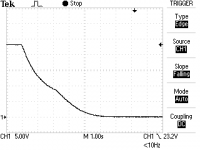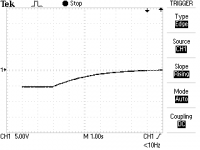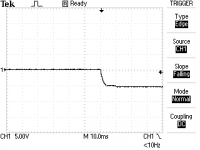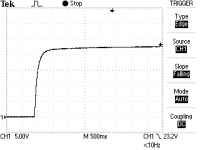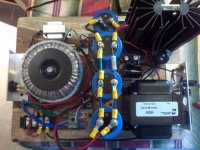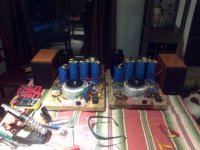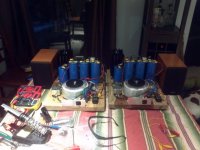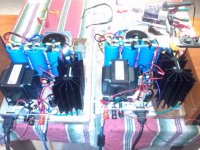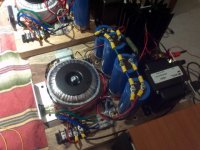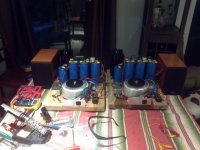........
I got KE devices I noticed KD as well. What is the difference?
nothing wrong with searching through half of web , and reading all Sony TA and Yamaha SIT amps threads , some of posts in this very thread ....... to know that Sony SIT T03 parts are divided in ranks , according to Ugs
.....

in short - all you need is to have them in same rank ; which one exactly - irrelevant , if you ask moi
tip : search for his posts about Sony parts :
diyAudio - View Profile: ilimzn
Thanks a lot Mr Michael Rothacher for the best single-ended L'Amp diy projectHappy Burning Amp Day!
and one more Happy Burning Amp Day



I'm planning to build this circuit: Say I duplicate this circuit except that my caps are a bit bigger, 3x 68k uF: http://www.audiohobby.com/pdf/lamp 193V.pdf, but one thing I thought of: if I've understood correctly the SITs cry smoke if the bias supply vanishes while the main rails still feed voltage?
Would I have to take that into account when I turn the amp on or off or is the capacitance enough on the bias supply to outlive the rail voltage? I have another unused 68k uF cap in the case that I could use in the bias supply too or would that just be massive overkill?
Would I have to take that into account when I turn the amp on or off or is the capacitance enough on the bias supply to outlive the rail voltage? I have another unused 68k uF cap in the case that I could use in the bias supply too or would that just be massive overkill?
Since this topic comes up now and then, and since it seems to cause angst, it may be worthwhile to take a few moments and go through it:
1. If I've never said it before, then I should point out that I have never lost a SIT device in over three years of experimentation (except the one I cut open on purpose). And, believe, me there were plenty of opportunities. They're fairly robust.
2. We've got a big cap and a big inductor to charge and discharge.
3. Assuming you have a speaker connected when you power on/off your amp (and you should), then these must discharge through the resistance of your speaker in parallel with any bleeder resistor you may have popped in there.
4. Let's consider what the turn off event really looks like in the circuit you reference:
Vds falls from 23V to zero in around 5 seconds. Vgs goes from -5.2V to zero in around 6 seconds. As Vgs goes to zero, Vds falls as well. There's no current spike, smoke, or explosions.
5. If you really want something to worry about, check this out:
Could life on Earth end on March 16 2880? Scientists predict giant asteroid will collide with our planet at 38,000 miles per hour | Mail Online
Good luck
1. If I've never said it before, then I should point out that I have never lost a SIT device in over three years of experimentation (except the one I cut open on purpose). And, believe, me there were plenty of opportunities. They're fairly robust.
2. We've got a big cap and a big inductor to charge and discharge.
3. Assuming you have a speaker connected when you power on/off your amp (and you should), then these must discharge through the resistance of your speaker in parallel with any bleeder resistor you may have popped in there.
4. Let's consider what the turn off event really looks like in the circuit you reference:
Vds falls from 23V to zero in around 5 seconds. Vgs goes from -5.2V to zero in around 6 seconds. As Vgs goes to zero, Vds falls as well. There's no current spike, smoke, or explosions.
5. If you really want something to worry about, check this out:
Could life on Earth end on March 16 2880? Scientists predict giant asteroid will collide with our planet at 38,000 miles per hour | Mail Online
Good luck
Attachments
Last edited:
Testing the power supply on the v193 L'amp and getting about 25.6v with no load.
I thought the 1 ohm resistor might drop the voltage by 2 volts, but not happening.
Both mono blocks exhibit same behavior. Anything to worry about at this point?
If voltage is OK at 25v, is the bias still set to -5 to -6v?
I thought the 1 ohm resistor might drop the voltage by 2 volts, but not happening.
Both mono blocks exhibit same behavior. Anything to worry about at this point?
If voltage is OK at 25v, is the bias still set to -5 to -6v?
Attachments
If voltage is OK at 25v, is the bias still set to -5 to -6v?
What Paul said + :
Vgs (the bias voltage) is device dependent. Set the drain around 22V, 2A.
Its a 5w resistor. Not enough?
It will dissipate 4W or so under load, which doesn't leave much of a safety margin so there's a possibility it will get hot, turn brown, and emit little puffs of smoke. 10W would be nice, when you have an opportunity to change it out. If you have more of those you could series-parallel them for a 1 ohm 20W resistor.
I'm always more concerned for spare towel ;
just in case

I plugged the L'amp 193v into my secondary system. I have a CD with some very well recorded music, listen to it often and know these songs really well. It's amazing how much information is pushed through the 193v.
I don't know what you'd call it, but goes something like this. For example, I hear a guitar being strum and I think I know the pattern and the rhythm when listening to this same CD. Enter the 193v, and the sound going to my ears is suddenly different. The strumming patter is different and I'm able to pick up more of the pattern.
I don't know if it's more power, the choke or the mono block configuration, but I'm just glad I did made them.
This is compared directly to the L'amp CCS and the Zen 9.
Now I need a preamp that can keep up with these amps!
Thanks Mike!
Vince
I don't know what you'd call it, but goes something like this. For example, I hear a guitar being strum and I think I know the pattern and the rhythm when listening to this same CD. Enter the 193v, and the sound going to my ears is suddenly different. The strumming patter is different and I'm able to pick up more of the pattern.
I don't know if it's more power, the choke or the mono block configuration, but I'm just glad I did made them.
This is compared directly to the L'amp CCS and the Zen 9.
Now I need a preamp that can keep up with these amps!
Thanks Mike!
Vince
- Home
- Amplifiers
- Pass Labs
- L'Amp: A simple SIT Amp

